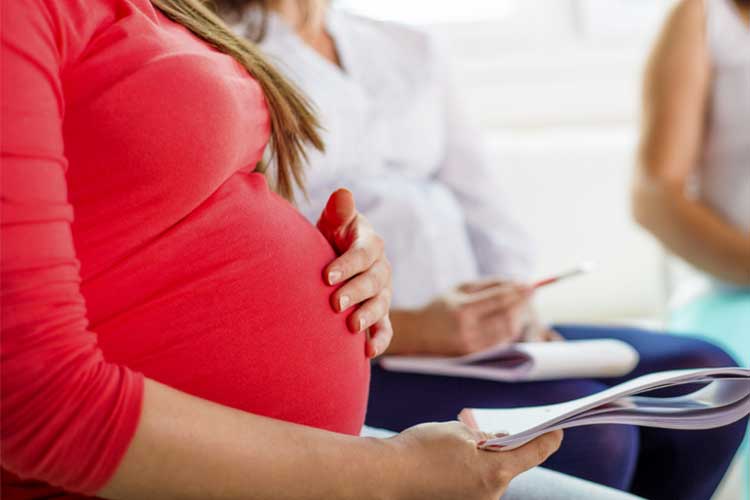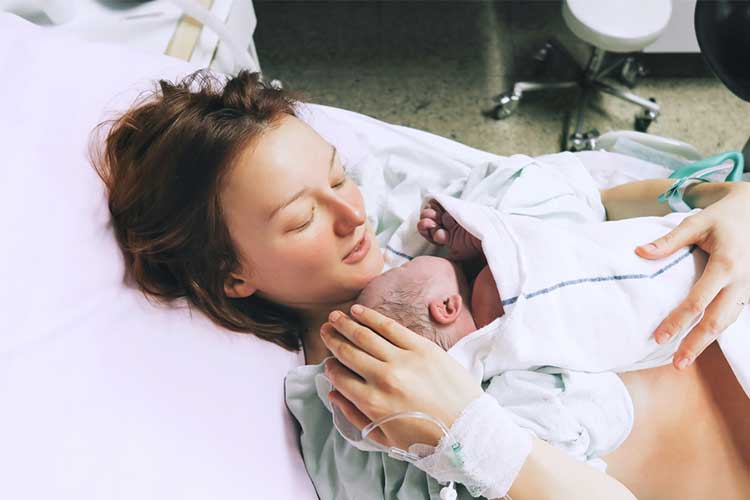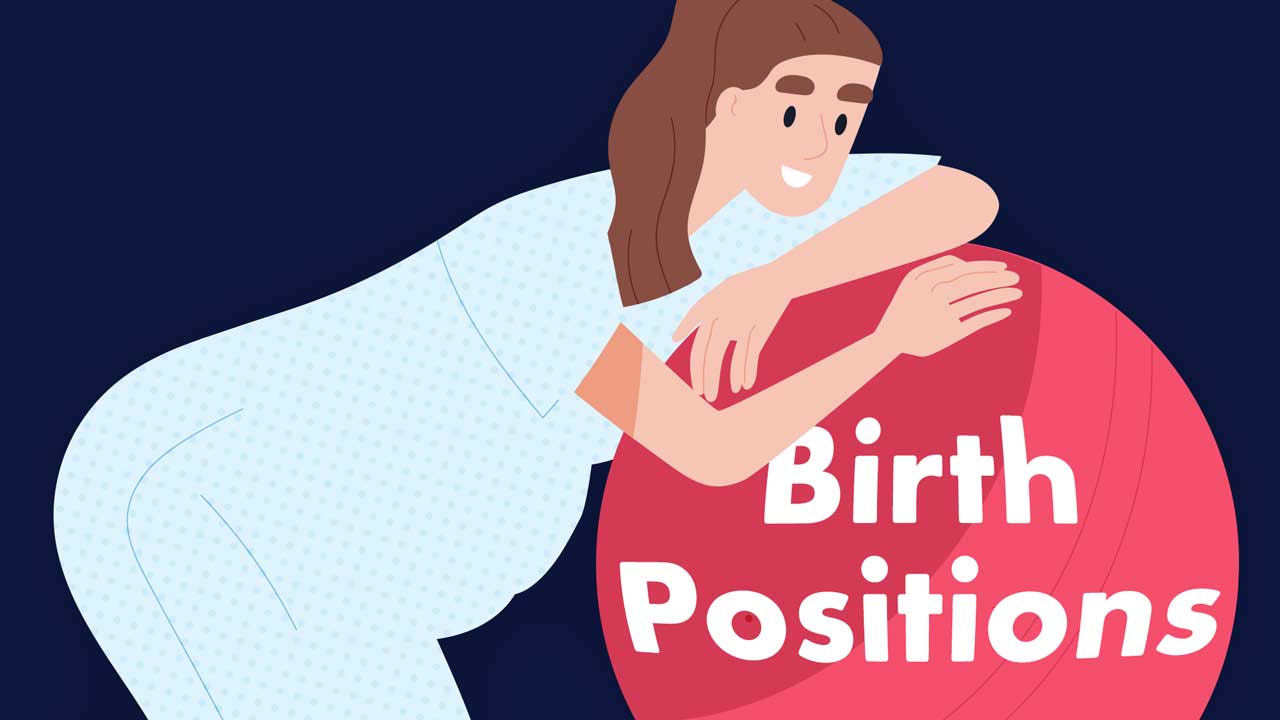It could be argued that the ideal position for a person to birth in is the one they adopt if they are not told what to do.
However, for midwives, the question is: which positions have the best maternal outcomes and how can this information be used to support the patients in their care?
Movement as a Coping Strategy
For a long time, lying supine was the most commonly used birthing position. This may largely be because birthing assistants are more comfortable with the lying or semi-sitting position because this is how most are trained to attend births (Gupta et al. 2017).
However, many studies suggest that the supine position is linked to negative maternal and neonatal outcomes. For example, Modrzejewska et al. (2019) suggest that horizontal positions are much less favourable. This is simply because when a person’s weight is mainly supported by their back, they need to push against gravity, putting the fetus in an unfavourable drive angle in relation to the pelvic floor.
On the other hand, those who use upright mobile positions are known to have shorter labours, receive less intervention, report less severe pain and describe more satisfaction with their birthing experience compared to those using recumbent positions. Added to this, the freedom to be mobile in labour is likely to be safer because it does not disrupt the normal physiological processes of birth (Ondeck 2014).
Benefits of the Upright Position
Throughout labour and delivery, maternal positions play an important role in the descent of the fetal head. It’s now widely acknowledged that remaining upright has greater benefits in facilitating labour progress than horizontal positions.
For example, a Cochrane review exploring the impact of different birthing positions shows that upright positions can reduce the duration of the second stage of labour by a mean of 6.6 minutes compared with supine positions (Huang et al. 2019).
Several physiological mechanisms are known to assist the progress of labour when an upright position is adopted:
- Gravity assists the effort of pushing
- Contractions are stronger and more effective
- The size of the pelvic diameter naturally increases enabling faster progress.
(Huang et al. 2019)

Whilst there is no compelling evidence to prove that upright positions affect the intensity of contractions or the rates of caesarean birth, many other benefits have been recognised:
- Vertical positions such as standing, squatting and kneeling are associated with a reduction in the duration of the second stage of labour
- Upright positions are associated with a significant reduction in instrumental deliveries
- Greater alignment of the fetus during the passage through the pelvis assists delivery
- Contractions assisted by gravity help support the birthing process.
(RCM 2018)
Modrzejewska et al. (2019) add the following benefits in support of upright birthing:
- Vertical positions make it possible to maintain the mobility of the pelvic floor, especially the sacroiliac joints, which allows it to reach its optimal capacity
- Staying in motion and in an upright position until the end of labour ensures maximal relaxation of the pelvic floor muscles
- Vertical positions increase the strength, frequency and regularity of uterine contractions
- The direction of gravity coinciding with the direction of expulsive uterine contractions allows the cervix to open more quickly
- Perineal damage is reduced as the pressure of the fetal head is focused more evenly in the centre of the outlet, rather than on the perineum, allowing the tissues to be stretched more evenly.
Upright positions are also associated with a reduction in pain, which can be explained by the possibility of ‘discharging the tension’ through greater freedom of movement together with less compression of the pelvic nerves by the pregnant uterus and fetus (Modrzejewska et al. 2019).
Birthing Positions Throughout the Stages of Labour
Birthing positions may change throughout the course of labour.
In stage 1 labour (about 4 to 6 cm dilation), lying on the back is not recommended as it may reduce blood supply to the fetus. Some patients may choose to lie on their side or sit with their feet up, while others might prefer to walk around, stand in the shower or sit in the bath (Pregnancy, Birth and Baby 2024).
Once the patient reaches active labour (4 to 10 cm dilation), they may choose a variety of positions such as:
- Kneeling with a chair or birthing ball for support
- Swaying or walking while holding onto a support person
- Standing or moving in the shower
- Sitting or kneeling in the bath
- Squatting, using a birthing stool, ball or squatting bar
- Sitting and rocking on a chair or edge of the bed
- Sitting backwards on a chair and resting arms on the back of the chair
- Leaning forward over a bed
- Sitting and leaning forward on a chair
- Lunging with one foot up on a chair or footstool
- Kneeling on the hands and knees.
(Pregnancy, Birth and Baby 2024)
In stage 2 labour (full dilation), a patient may choose to:
- Position themself upright
- Lie on their back
- Kneel
- Go on all fours
- Sit in a semi-recumbent position
- Lie on their side with their top leg bent.
(Pregnancy, Birth and Baby 2024)
The Importance of Shared Decision-making

Midwives have always played a pivotal role in helping patients find the best positions for labour and birth. Informed choice and the use of birth plans go a long way to help patients feel confident in moving about and selecting the birth position of their choice.
Shared decision-making is not a linear process but rather a dynamic process that requires a variety of approaches. As Nieuwenhuijze et al. (2014) suggest, midwives should ideally take a flexible approach that incorporates clinical assessment and respects the patient’s personal preferences.
Having the flexibility to adapt the birth plan and respond as needs arise during labour progression is also endorsed by the Care Quality Commission (2018), which recommends that professionals encourage and help patients move about and adopt whatever positions they find most comfortable throughout labour.
It’s a recommendation echoed by the Royal College of Midwives (2018), which suggests that:
- Midwives should support patients to adopt any position they choose during labour and birth and to change positions as and when they want to
- Midwives should advise patients that upright positions during the second stage of labour may reduce the likelihood of interventions such as instrumental births, episiotomies and concern about fetal heart patterns.
Practice Points
Most researchers agree that patients should be encouraged to give birth in whatever position they find most comfortable (Gupta et al. 2017).
Medical equipment should be made to work around the patient’s choice of positions. Many patients strongly dislike the lithotomy position and its use should be limited to facilitating certain procedures such as instrumental delivery or fetal blood sampling, and then discontinued immediately afterwards (RCM 2018).
Midwives, doulas and birthing assistants have always played an important role in supporting patients in their use of different birthing positions. For patients with low obstetric risk, the freedom to explore a range of positions during delivery should always be encouraged. It’s a core skill for midwives and doulas and a key contribution towards a positive birth experience.

Topics
References
- Care Quality Commission 2018, 2017 Survey of Women’s Experiences of Maternity Care Statistical Release, National Health Service, viewed 27 November 2024, https://www.cqc.org.uk/sites/default/files/20180130_mat17_statisticalrelease.pdf
- Gupta, J, Sood, A, Hofmeyr, G & Vogel, J 2017, ‘Position in the Second Stage of Labour for Women Without Epidural Anaesthesia’, Cochrane Database of Systematic Reviews, vol. 5, no. 5, viewed 27 November 2024, https://pubmed.ncbi.nlm.nih.gov/28539008/
- Huang, J, Zang, Y, Ren, L, Li, F & Lu, H 2019, ‘A Review and Comparison of Common Maternal Positions During the Second-Stage of Labor’, International Journal of Nursing Sciences, vol. 6, no. 4, viewed 27 November 2024, https://doi.org/10.1016/j.ijnss.2019.06.007
- Modrzejewska, E, Torbé, D & Torbé, A 2019, ‘The Evolution of Maternal Birthing Positions’, Journal of Education, Health and Sport, vol. 9, no. 8, viewed 27 November 2024, http://dx.doi.org/10.5281/zenodo.3408045
- Nieuwenhuijze, M, Low, L, Korstjens, I and Lagro-Janssen, T 2014, ‘The Role of Maternity Care Providers in Promoting Shared Decision Making Regarding Birthing Positions During the Second Stage of Labor’, Journal of Midwifery & Women's Health, vol. 59, no. 3, pp.277-285, https://onlinelibrary.wiley.com/doi/10.1111/jmwh.12187
- Ondeck, M 2014, ‘Healthy Birth Practice #2: Walk, Move Around, and Change Positions Throughout Labor', The Journal of Perinatal Education, vol. 23, no. 4, viewed 27 November 2024, https://www.ncbi.nlm.nih.gov/pmc/articles/PMC4235058/
- Pregnancy, Birth and Baby 2024, Positions for Labour and Birth, Healthdirect Australia, viewed 27 November 2024, https://www.pregnancybirthbaby.org.au/positions-for-labour-and-birth
- Royal College of Midwives 2018, Midwifery Care in Labour Guidance For All Women in All Settings, RCM, viewed 27 November 2024, https://pdf4pro.com/view/midwifery-care-in-labour-guidance-for-all-women-in-all-6ba1ca.html
 New
New 
